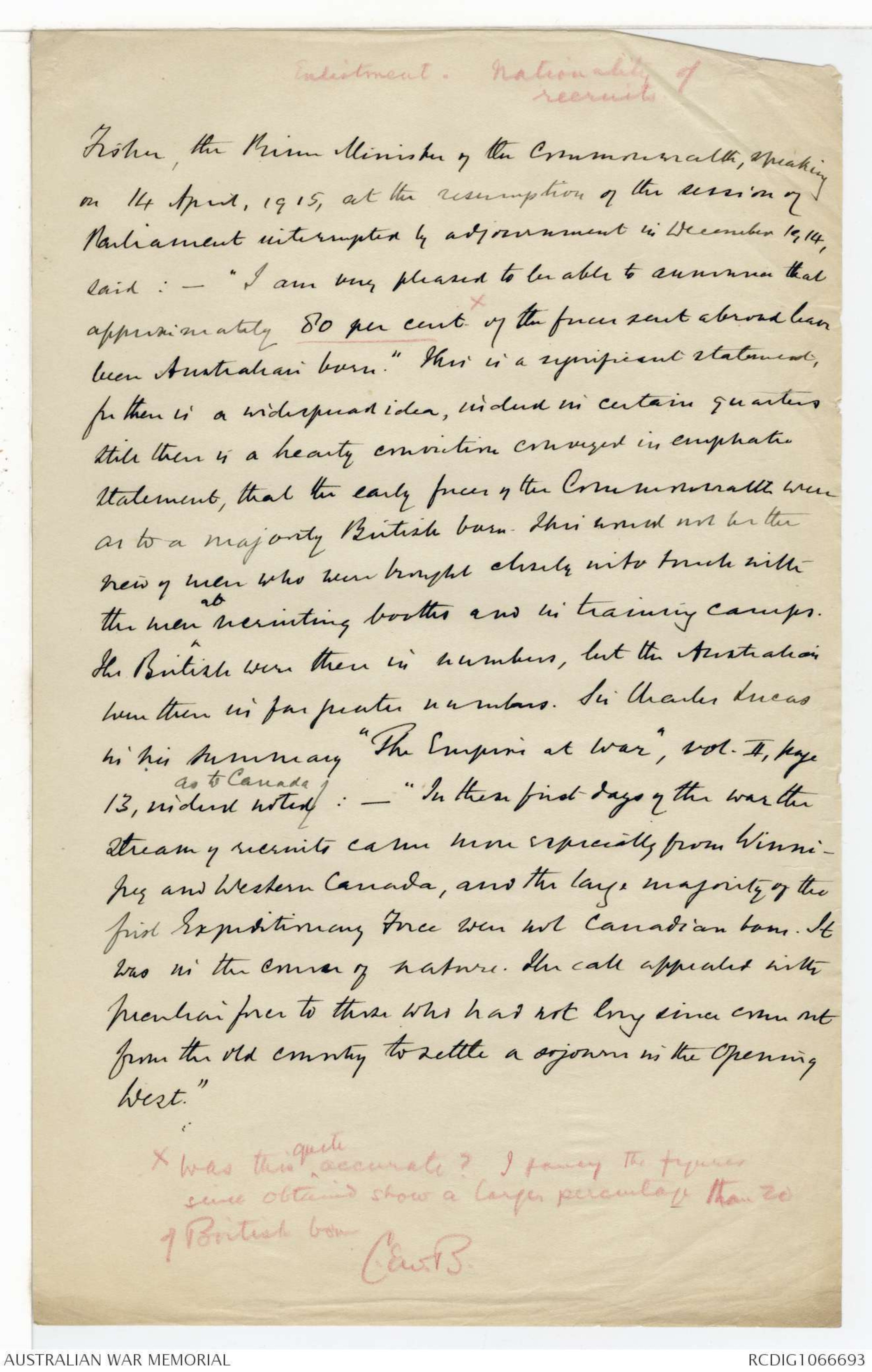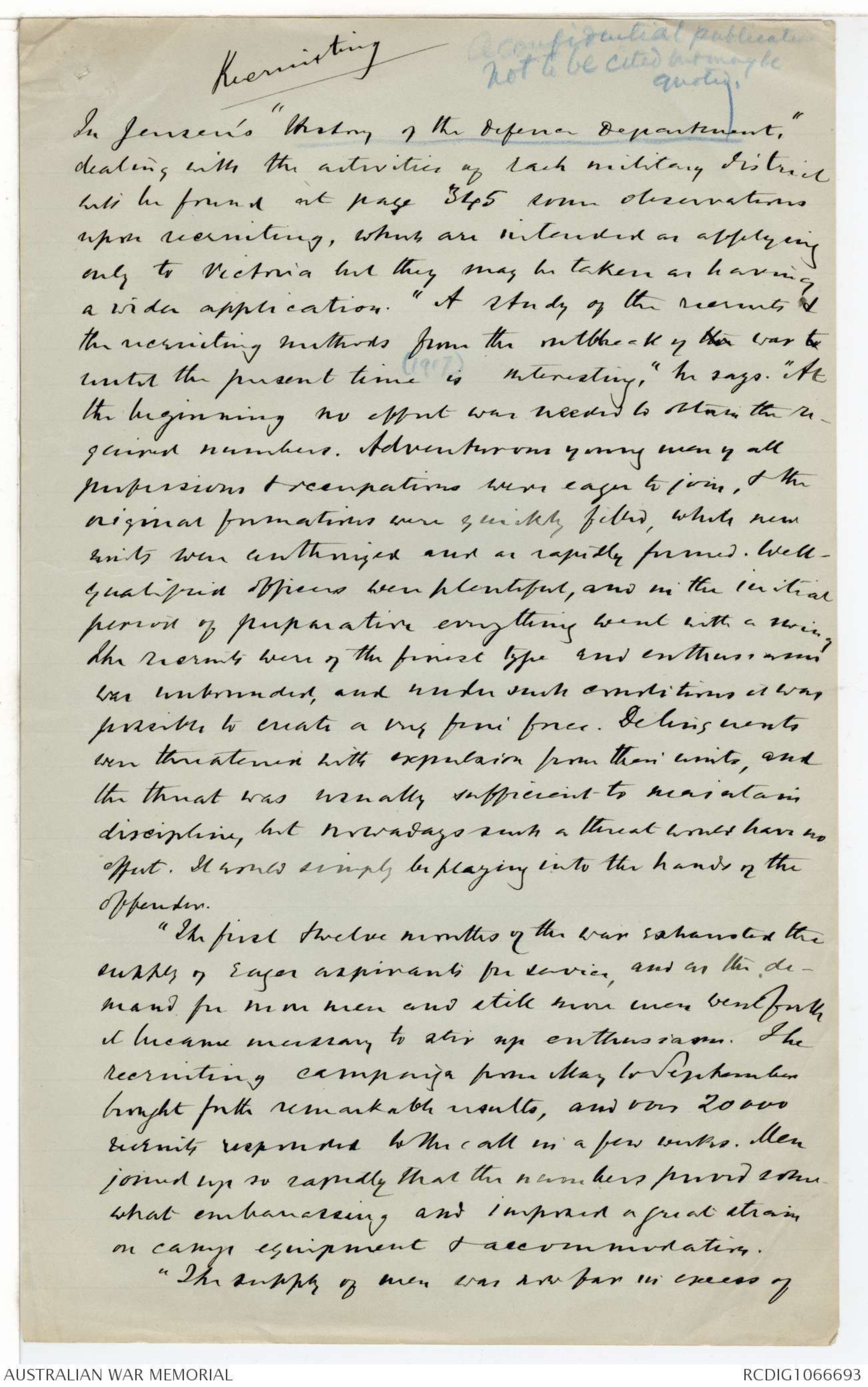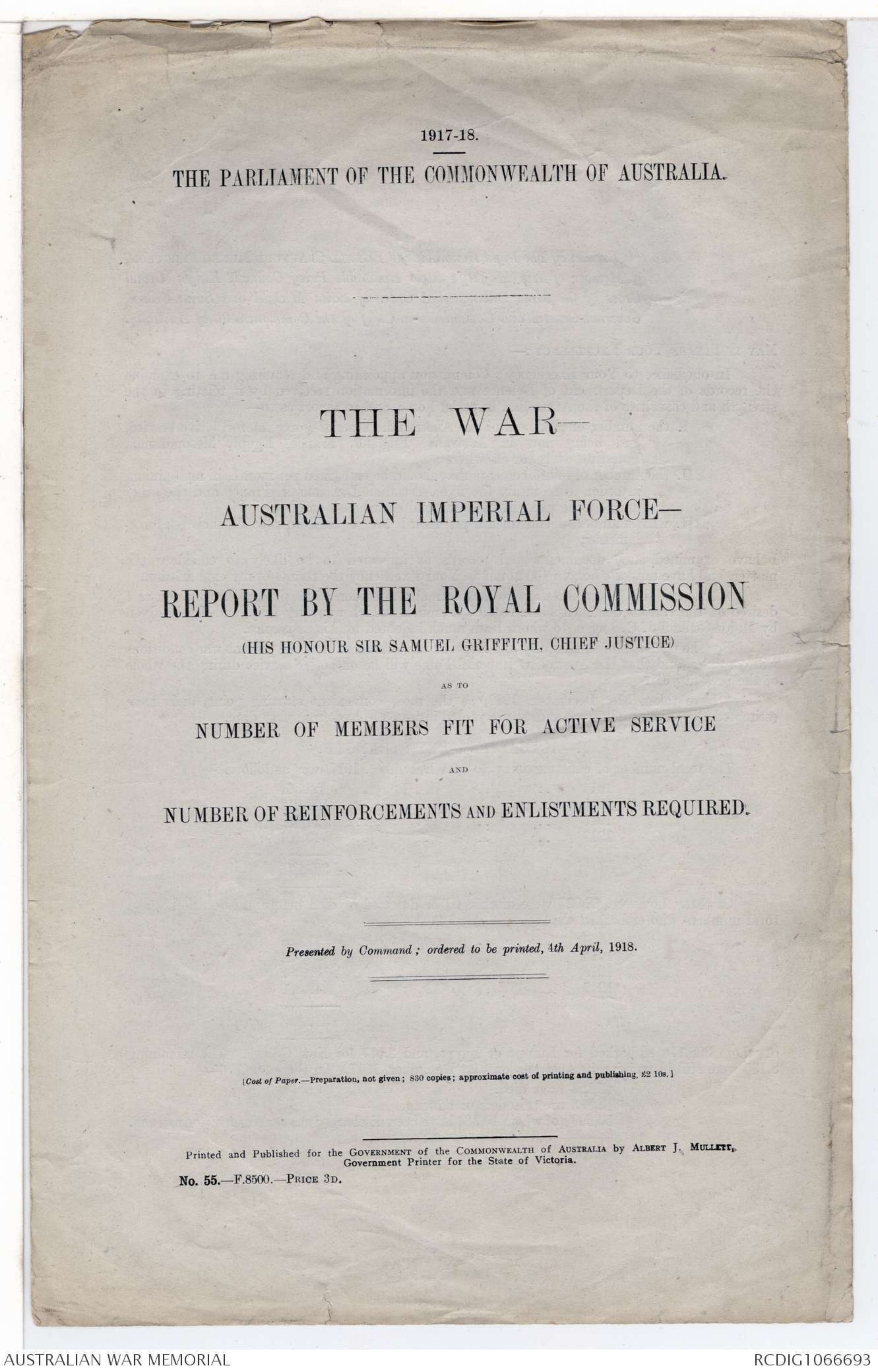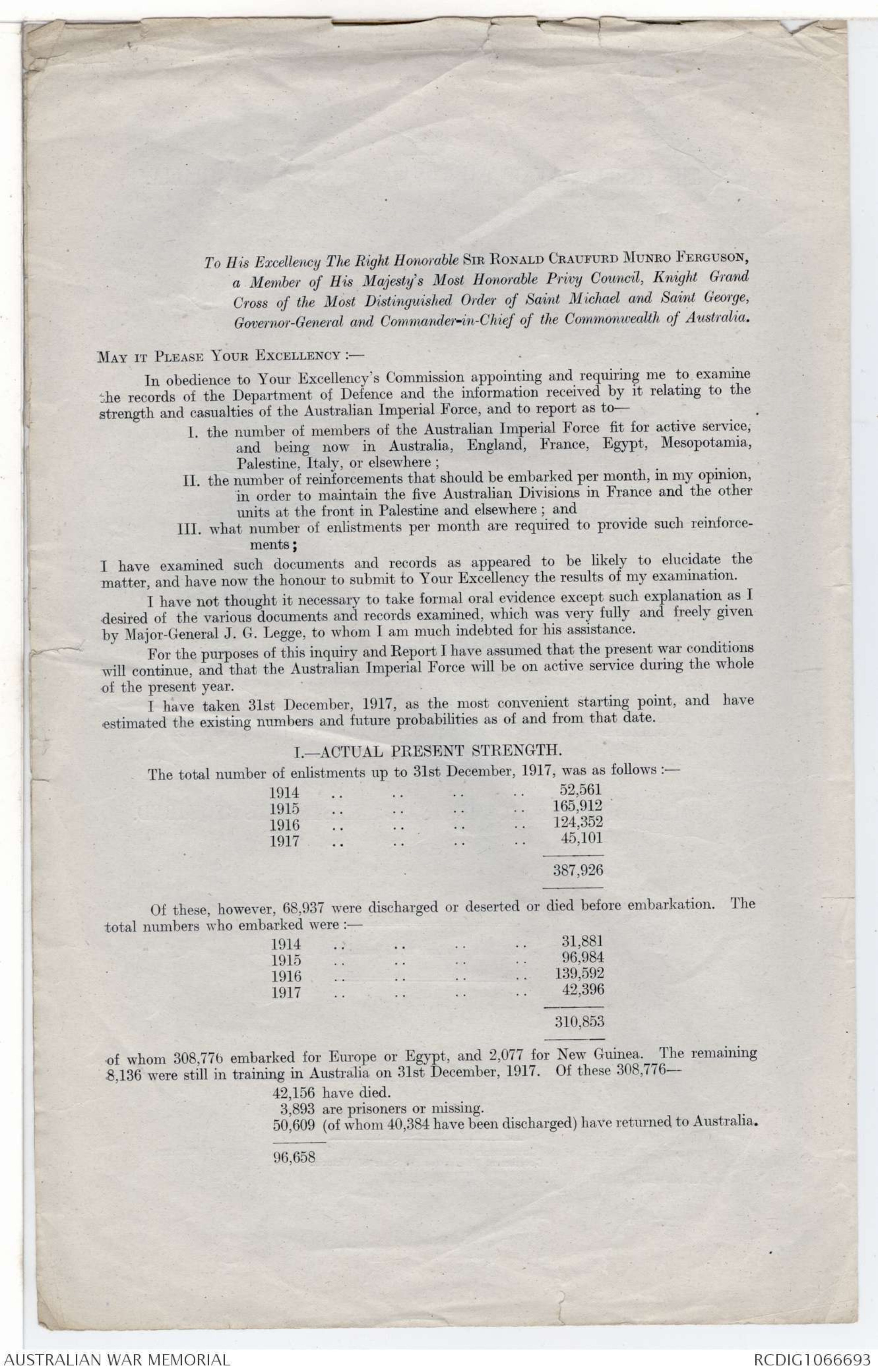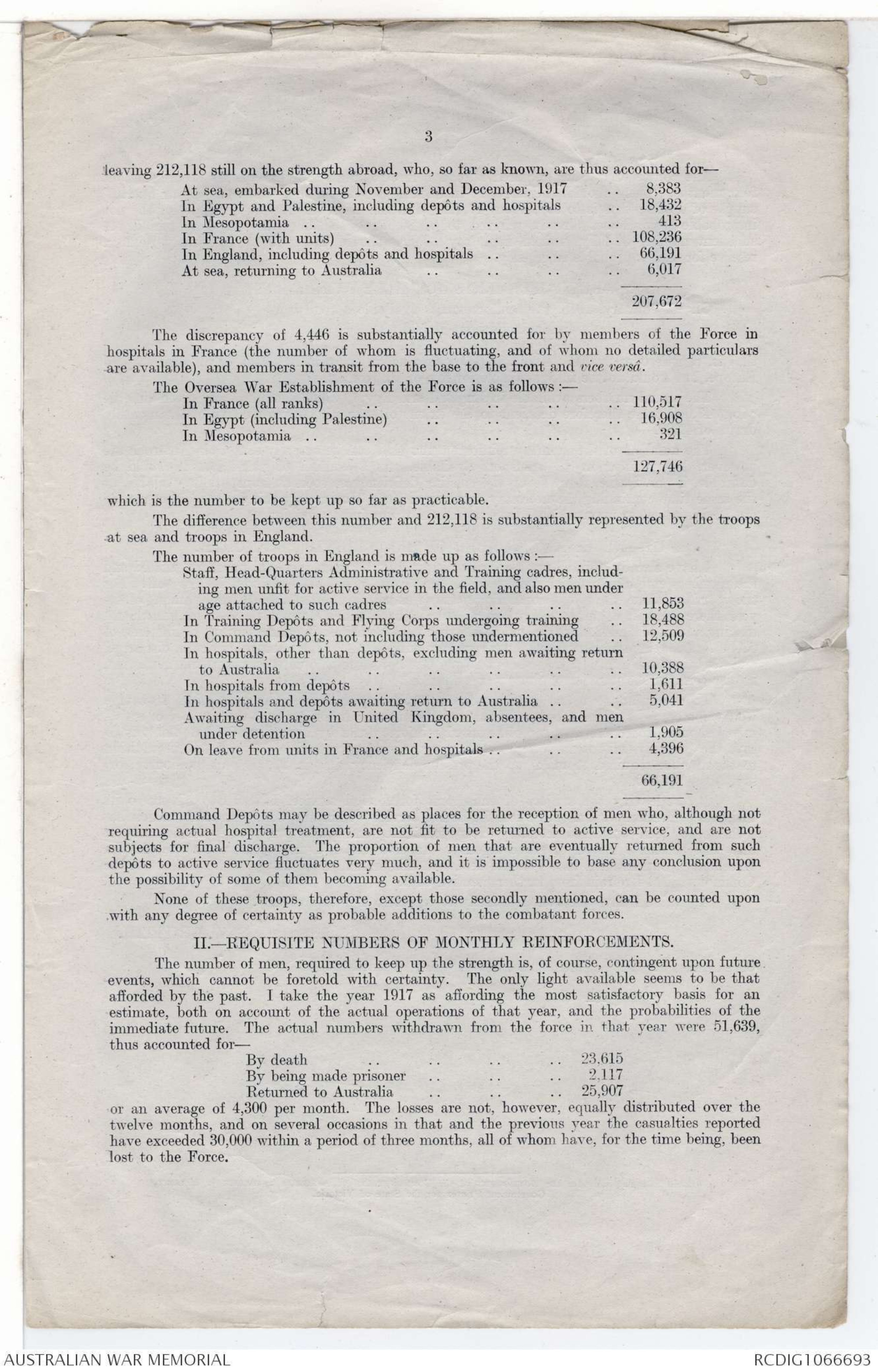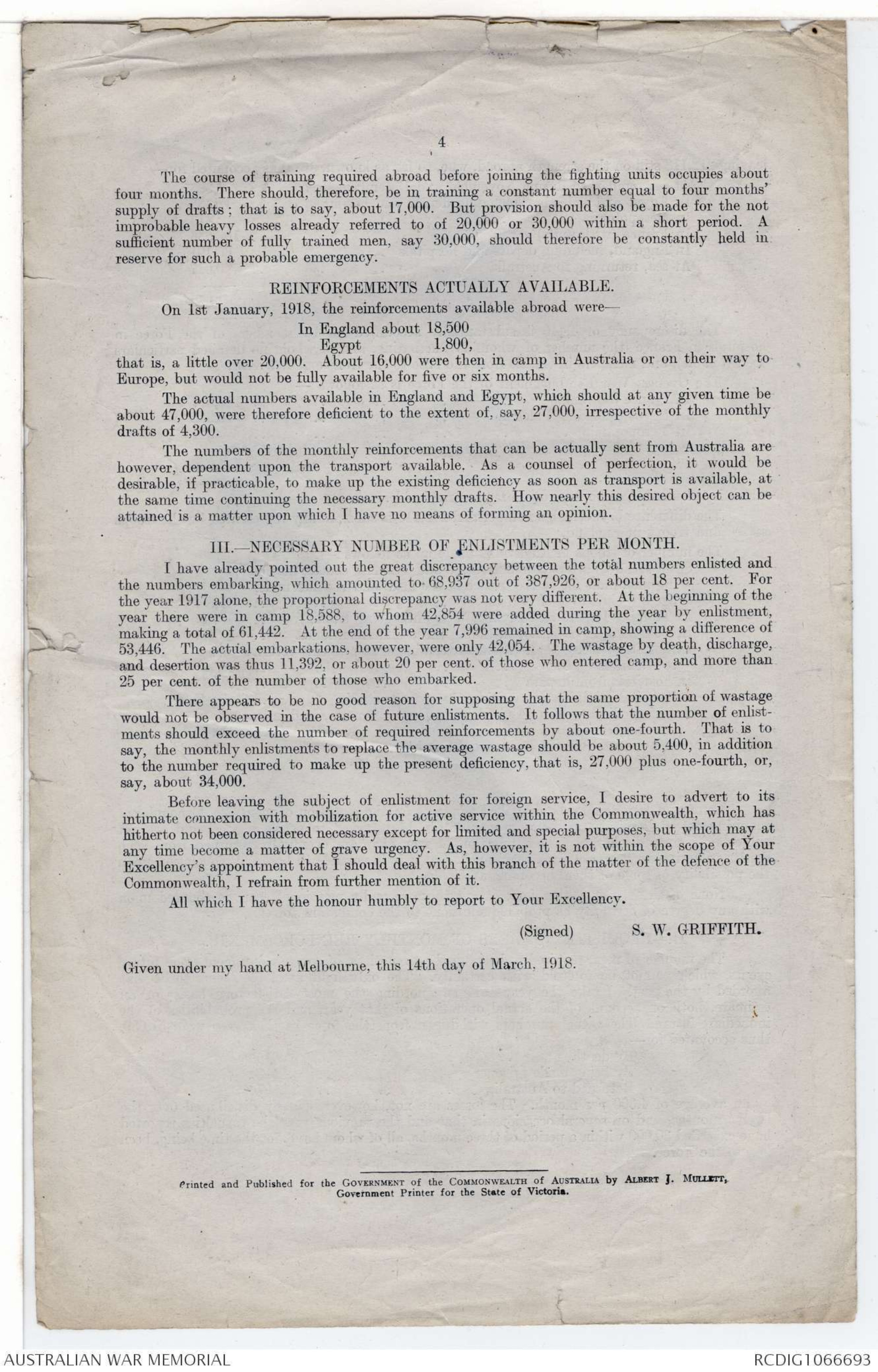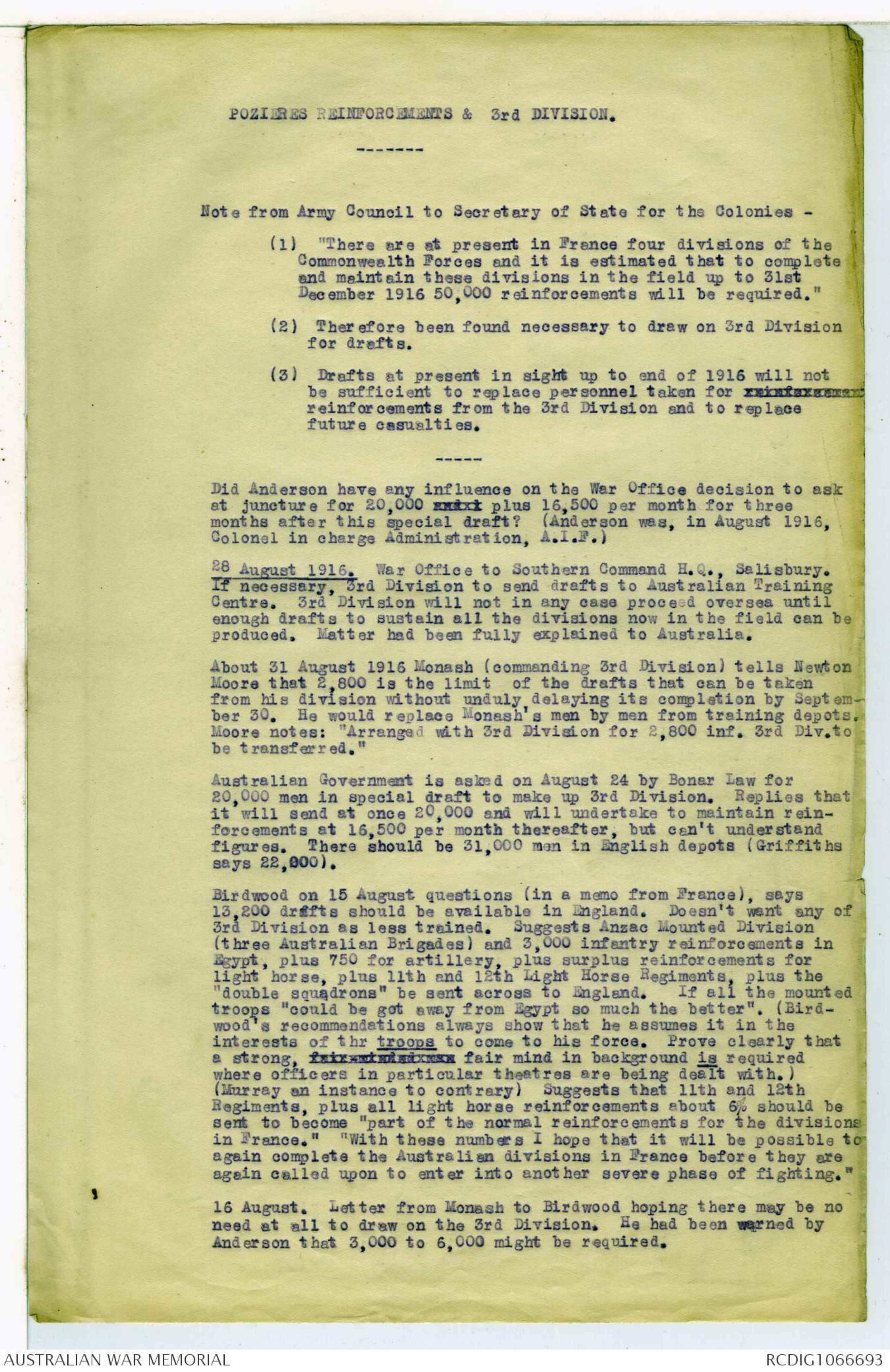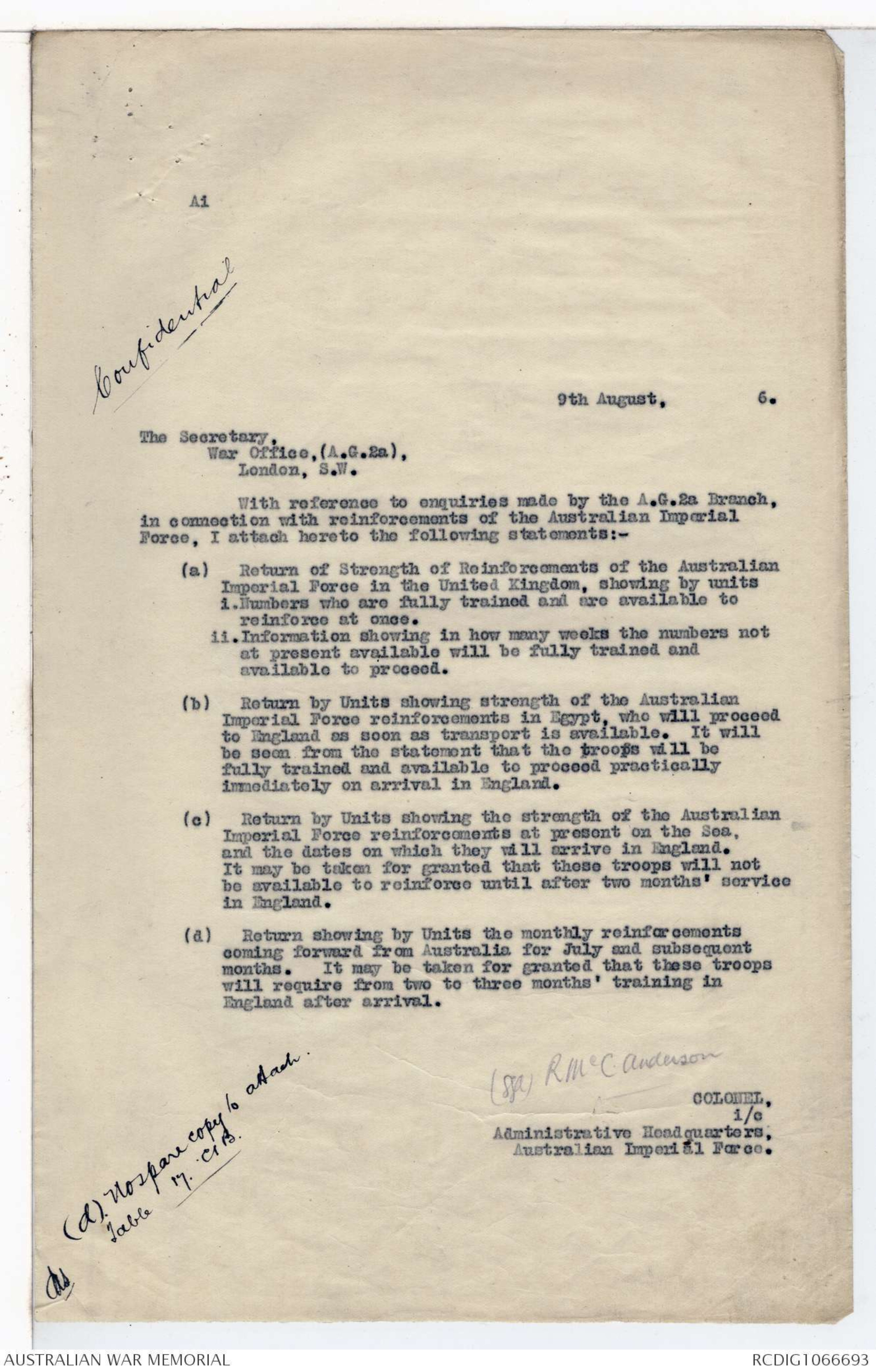Charles E W Bean, Diaries, AWM38 3DRL 606/257/1 - 1916 - 1927 - Part 12
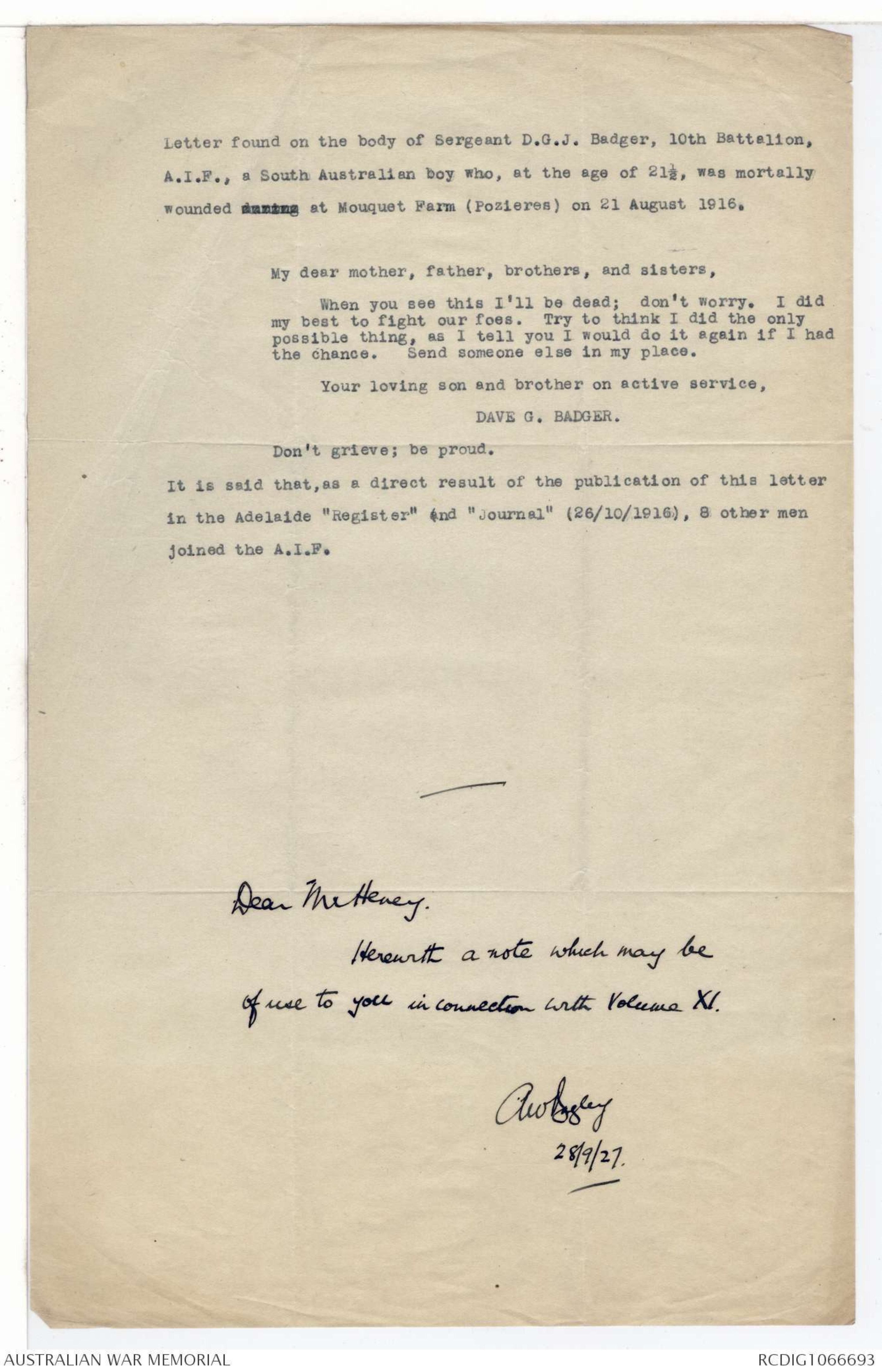
Letter found on the body of Sergeant D.G.J. Badger, 10th Battalion,
A.I.F., a South Australian boy who, at the age of 21½, was mortally
wounded xxxxxx at Mouquet Farm (Pozieres) on 21 August 1916.
My dear mother, father, brothers, and sisters,
When you see this I'll be dead; don't worry. I did
my best to fight our foes. Try to think I did the only
possible thing, as I tell you I would do it again if I had
the chance. Send someone else in my place.
Your loving son and brother on active service,
DAVE G. BADGER.
Don't grieve; be proud.
It is said that,as a direct result of the publication of this letter
in the Adelaide "Register" and "Journal" (26/10/1916), 8 other men
joined the A.I.F.
Enlistment - Nationality of
recruits.
Fisher, the Prime Minister of the Commonwealth, speaking
on 14 April, 1915, at the resumption of the session of
Parliament interrupted by adjournment on December 1914,
said : - "I am very pleased to be able to announce that
approximately 80 per centX of the forces sent abroad have
been Australian born." This is a significant statement,
for there is a widespread idea, indeed in certain quarters
still there is a hearty conviction conveyed in emphatic
statement, that the early forces of the Commonwealth were
as to a majority British born. This would not be the
view of men who were brought [[?]] into [[?]] with
the men ^at recruiting booths and in training camps.
The British were there in numbers, but the Australians
were there in far greater numbers. Sir Charles Lucas
in his summary "The Empire at War", vol.ii, page
13, indeed noted/ as to Canada : - "In these first days of the war the
stream of recruits came more especially from Winnipeg
and Western Canada, and the large majority of the
first Expeditionary Force were not Canadian born. It
was in the course of nature. The call appealed with
peculiar force t those who had not long since come out
from the old country to settle or sojourn in the Opening
West."
X Was this ^quite accurate? I fancy the figures
since obtained show a larger percentage than 20
of British born
C.E.W.B.
Recruiting
A confidential publication
not to be cited but may be
quoted.
In Jensen's "History of the Defence Department,"
dealing with the activities of each military district
will be found at page 345 some observations
upon recruiting, which are intended as applying
only to Victoria but they may be taken as having
a wider application. "A study of the recruits &
the recruiting methods from the outbreak of the war to
until the present time (1917) is interesting," he says. "At
the beginning no effort was needed to obtain the required
numbers. Adventurous young men of all
professions & occupations were eager to join, & the
original formations were quickly filled, while new
units were authorized and just as rapidly formed. Well-
qualified officers were plentiful, and in the initial
period of preparation everything went with a swing,
the recruits were of the finest type and enthusiasm
was unbounded, and under such conditions it was
possible to create a big fine force. Delinquents
were threatened with expulsion from their units, and
the threat was usually sufficient to maintain
discipline but nowadays such a threat has no
effect. It would simply be playing into the hands of the
offender.
"The first twelve months of the war exhausted the
supply of eager aspirants for service, and as the demand
for more men and still more men went forth
it became necessary to stir up enthusiasm. The
recruiting company's from May to September
brought forth remarkable results, and over 20 000
recruits responded to the call in a few months. Men
joined up so rapidly that the numbers proved somewhat
embarrassing and imposed a great strain
on camp equipment and accommodation.
"The supply of men was [[?]] far in excess of
the number required for immediate reinforcements,
and new units were offered and accepted. These formations
absorbed much of the surplus, but in spite
of this many men served many months before their turn
came to go abroad.
"After this rush the enlistments declined until
the time of the "call to arms" movement from January
to March of 1916, when large numbers of men
again came forward. A further decline then commenced,
since when there has not bee a revival.
"It will be seen therefore that the supply of recruits has
been irregular. First a period of plenty, then a lull,
next a rush, quietness again, a revival, and finally
a long period of steady decline. Recruiting
campaigns have been fitful, a wave of enthusiasm
followed by a spell of inactivity.
"The characteristics of the men enlisting appears
to have undergone some change. The wild boisterous
spirits of the early days eager for adventure
are no longer prominent. The men who enlist
now [[??]] impelled by a sense of duty, and
no doubt some of them [[have been?]] forced into enlisting
by the scornful taunts of the women of the community
or the fear of being branded as slackers.
" Whatever is the underlying reason they mostly recognize
the seriousness of the job they have undertaken.
The joyousness of the early camps has been replaced by a
steady sobriety of demeanour. One does not hear the
boisterous fun of at camp concerts so characteristic
of the early days. The nightly stadium fights which
were the delight of thousands of the first recruits, are
now almost extinct. Recruits now enjoy a good
concert or a good boxing match but they do not
get wildly enthusiastic about it."
1917-18.
THE PARLIAMENT OF THE COMMONWEALTH OF AUSTRALIA.
THE WAR -
AUSTRALIAN IMPERIAL FORCE -
REPORT BY THE ROYAL COMMISSION
(HIS HONOUR SIR SAMUEL GRIFFITH, CHIEF JUSTICE)
AS TO
NUMBER OF MEMBERS FIT FOR ACTIVE SERVICE
AND
NUMBER OF REINFORCEMENTS AND ENLISTMENTS REQUIRED.
Presented by Command ; ordered to be printed, 4th April, 1918.
(Cost of paper.- Preparation, not given; 830 copies; approximate cost of printing and publishing, £2 10s.)
Printed and Published for the GOVERNMENT of the COMMONWEALTH of AUSTRALIA by ALBERT J. MULLETT,
Government Printer for the State of Victoria.
No. 55.-F.8500.-PRICE 3D.
To His Excellency The Right Honorable SIR RONALD CRAUFORD MUNRO FERGUSON,
a Member of His Majesty's Most Honorable Privy Council, Knight Grand
Cross of the Most Distinguished Order of Saint Michael and Saint George,
Governor-General and Commander-in-Chief of the Commonwealth of Australia.
MAY IT PLEASE YOUR EXCELLENCY :-
In obedience to Your Excellency's Commission appointing and requiring me to examine
the records of the Department of Defence and the information received by it relating to the
strength and casualties of the Australian Imperial Force, and to report as to-
i. the number of members of the Australian Imperial Force fit for active service,
and being now in Australia, England, France, Egypt, Mesopotamia,
Palestine, Italy, or elsewhere;
ii. the number of reinforcements that should be embarked per month, in my opinion,
in order to maintain the five Australian Divisions in France and the other
units at the front in Palestine and elsewhere; and
iii. what numbers of enlistments per month are required to provide such reinforcements;
I have examined such documents and records as appeared to be likely to elucidate the
matter, and have now the honour to submit to Your Excellency the results of my examination.
I have not thought it necessary to take formal oral evidence except such explanation as I
desired of the various documents and records examined, which was very fully and freely given
by Major-General J. G. Legge, to whom I am much indebted for his assistance.
For the purposes of this enquiry and Report I have assumed that present war conditions
will continue, and that the Australian Imperial Force will be on active service during the whole
of the present year.
1.- ACTUAL PRESENT STRENGTH.
The total number of enlistments up to 31st December, 1917, was as follows:-
1914 .. .. .. .. 52,561
1915 .. .. .. .. 165,912
1916 .. .. .. .. 124,352
1917 .. .. .. .. 45,101
387,926
Of these, however, 68,937 were discharged or deserted or died before embarkation. The
total numbers who embarked were:-
1914 .. .. .. .. 31,881
1915 .. .. .. .. 96,984
1916 .. .. .. ..139,592
1917 .. .. .. .. 42,396
310,853
of whom 308,776 embarked for Europe or Egypt, and 2,077 for New Guinea. The remaining
8,136 were still in training in Australia on 31st December, 1917. Of these 308,776-
42,156 have died.
3,893 are prisoners or missing.
50,609 (of whom 40,384 have been discharged) have returned to Australia.
96,658
3
leaving 212,118 still on the strength abroad, who, so far as known, are thus accounted for-
At sea, embarked during November and December, 1917 .. 8,383
In Egypt and Palestine, including depots and hospitals .. 18,432
In Mesopotamia .. 413
In France (with units) .. 108,236
In England, including depots and hospitals .. 66,191
AT sea, returning to Australia .. 6,017
207,672
The discrepancy of 4,446 is substantially accounted for by members of the Force in
hospitals in France (the number of which is fluctuating, and of whom no detailed particulars
are available), and members in transit from the base to the front and vice versâ.
The Oversea War Establishment of the Force is as follows:-
In France (all ranks) .. 110,517
In Egypt (including Palestine .. 16,908
In Mesopotamia .. 321
127,746.
which is the number to be kept up as far as practicable.
The difference between this number and 212,118 is substantially represented by the troops
at sea and the troops in England.
The number of troops in England is made up as follows:-
Staff, Head-Quarters Administrative and Training cadres, including
men unfit for active service in the field, and also men under
age attached to such cadres .. .. .. .. .. .. .. 11,853
In Training Depôts and Flying Corps undergoing training .. 18,488
In Command Depôts, not including those undermentioned .. 12,509
In hospitals, other than depôts, excluding men awaiting return
to Australia .. .. .. .. .. .. .. .. .. .. 10,388
In hospitals from depôts .. .. . .. .. .. .. .. 1,611
In hospitals and depôts awaiting return to Australia .. .. .. 5,041
Awaiting discharge in United Kingdom, absentees, and men
under detention .. .. .. .. .. .. .. .. 1,905
On leave from units in France and hospitals .. .. .. .. .. 4,396
Command Depôts may be described as places for the reception of men who, although not
requiring actual hospital treatment, are not fit to be returned to active service, and are not
subjects for final discharge. The proportion of men that are eventually returned from such
depôts to active service fluctuates very much, and it is impossible to base any conclusion upon
the possibility of some of them becoming available.
None of these troops, therefore, except those secondly mentioned, can be counted upon
with any degree of certainty as probable additions to the combatant forces.
II.- REQUISITE NUMBERS OF MONTHLY REINFORCEMENTS.
The number of men, required to keep u the strength is, of course, contingent upon future
events, which cannot be foretold with certainty. The only light available seems to be that
afforded by the past. I take the year 1917 as affording the most satisfactory basis for an
estimate, both on account of the actual operations of the year, and the probabilities of the
immediate future. The actual numbers withdrawn from the force that year were 51,639,
thus accounted for-
By death .. .. .. .. .. 23,615
By being made prisoner .. 2,117
Returned to Australia .. .. 25,907
or an average of 4,300 per month. The losses are not , however, equally distributed over the
twelve months, and on several occasions in that and the previous year the casualties reported
have exceeded 30,000 within a period of three months, all of whom have, for the time being, been
lost to the Force.
4
The course of training required abroad before joining the fighting units occupies about
four months. There should, therefore, be in training a constant number equal to four months'
supply of drafts; that is to say, about 17,000. But provision should also be made for the not
improbably heavy losses already referred to of 20,000 or 30,000 within a short period. A
sufficient number of fully trained men, say 30,000, should therefore be constantly held in
reserve for such a probable emergency.
REINFORCEMENTS ACTUALLY AVAILABLE.
On 1st January, 1918, the reinforcements available abroad were -
In England about 18,500
Egypt 1,800,
that is, a little over 20,000. About 16,000 were then in camp in Australia or on their way to
Europe, but would not be fully available for five or six months.
The actual numbers available in England and Egypt, which should at any given time be
about 47,000, were therefore deficient to the extent of, say, 27,000, irrespective of the monthly
drafts of 4,300.
The numbers of the monthly reinforcements that can be actually sent from Australia are
however dependent upon the transport available. As a counsel of perfection, it would be
desirable, if practicable. to make up the existing deficiency as soon as transport is available, at
the same time continuing the necessary monthly drafts. How nearly this desired object can be
attained is a matter upon which I have no means of forming an opinion.
III.- NECESSARY NUMBER OF ENLISTMENTS PER MONTH.
I have already pointed out the great discrepancy between the total numbers enlisted and
the numbers embarking, which amounted to 68,937 out of 387,926, or about 18%. For
the year 1917 alone, the proportional discrepancy was not very different. At the beginning of the
year there were in camp 18,588, to whom 42,854 were added during the year by enlistment,
making a total of 61,442. At the end of the year 7,996 remained in camp, showing a difference of
53,446. The actual embarkations, however, were only 42,854. The wastage by death, discharge,
and desertion was thus 11,392, or about 20 per cent. of those who entered camp, and more than
25 per cent. of the number of those who embarked.
There appears to be no good reason for supposing that the same proportion of wastage
would not be observed in the case of future enlistments. It follows that the number of enlistments
should exceed the number of required reinforcements by about one-fourth. That is to
say, the monthly enlistments to replace the average wastage should be about 5,400, in addition
to the number required to make up the present deficiency, that is, 27,000 plus one-fourth, or,
say, about 34,000.
Before leaving the subject of enlistment for foreign service, I desire to advert to its
intimate connexion with mobilization for active service within the Commonwealth, which has
hitherto not been considered necessary except for limited and special purposes, but which may at
any time become a matter of grave urgency. As however, it is not within the scope of Your
Excellency's appointment that I should deal with this branch of the matter of defence of the
Commonwealth, I refrain from further mention of it.
All which I have the honour humbly to report to Your Excellency.
(Signed) S.W. GRIFFITH.
Given under my hand at Melbourne, this 14th day of March, 1918.
Printed and Published for the GOVERNMENT of the COMMONWEALTH of AUSTRALIA by ALBERT J. MULLETT,
Government Printer for the State of Victoria.
POZIERES REINFORCEMENTS & 3rd DIVISION.
Note from Army Council to Secretary of State for the Colonies -
(1) "There are at present in France four divisions of the
Commonwealth Forces and it is estimated that to complete
and maintain these divisions in the field up to 31st
December 1916 50,000 reinforcements will be required."
(2) Therefore been found necessary to draw upon 3rd Division
for drafts.
(3) Drafts at present in sight up to end of 1916 will not
be sufficient to replace personnel taken for xxxxxxxxx
reinforcements from the 3rd Division and to replace
future casualties.
Did Anderson have any influence on the War office decision to ask
at juncture for 20,000 xxxx plus 16,500 per month for three
months after this special draft? Anderson was, in August 1916,
Colonel in charge Administration, A.I.F.)
28 August 1916. War Office to Southern Command H.Q. Salisbury.
If necessary, 3rd Division to send drafts to Australian Training
Centre. 3rd Division will not i8n any case proceed oversea until
enough drafts to sustain all the divisions now in the field can be
produced. Matter had been fully explained to Australia.
About 31 August 1916 Monash (commanding 3rd Division) tells Newton
Moore that 2,80 is the limit of the drafts that can be taken
from his division without unduly delaying its completion by September
30. He would replace Monash's men by men from training depots.
Moore notes: "Arranged with 3rd Division for 2,800 inf. 3rd Div.to
be transferred."
Australian Government is asked on August 24 by Bonar Law for
20,000 men in special draft to make up 3rd Division. Replies that
it will send at once 20,000 and will undertake to maintain reinforcements
at 16,500 per month thereafter, but can't understand
figures. There should be 31,000 men in English depots (Griffiths
says 22,000).
Birdwood on 15 August questions (in a memo from France), says
13,200 drafts should be available in England. Doesn't want any of
3rd Division as less trained. Suggests Anzac Mounted Division
(three Australian Brigades) and 3,000 infantry reinforcements in
Egypt, plus 750 for artillery, plus surplus reinforcements for
light horses, plus 11th and 12th Light Horse Regiments, plus the
"double squadrons" be sent across to England. If all the mounted
troops "could be got away from Egypt so much the better". (Birdwood's
recommendations always show that he assumes it in the
interests of thr troops to come to his forces. Prove clearly that
a strong, xxxxxxxxxxxxx fair mind in the background is required
where officers in particular theatres are being dealt with.)
(Murray an instance to contrary) Suggests that 11th and 12th
regiments, plus all light horse reinforcements about 6% should be
sent to become "part of the normal reinforcements for the divisions
in France." "With these numbers I hope that it will be possible to
again complete the Australian divisions in France before they are
again called upon to enter into another severe phase of fighting."
16 August. Letter from Monash to Birdwood hoping there may be no
need at all to draw on the 3rd Division. He had been warned by
Anderson that 3,000 to 6,0000 might be required.
Ai
Confidential
9th August, 6.
The Secretary,
War Office,(A.G.2a),
London, S.W.
With reference to enquiries made by the A.G.2a Branch,
in connection with reinforcements of the Australian Imperial
Force, I attach hereto the following statements:-
(a) Return of strength of Reinforcements of the Australian
Imperial Force in the United Kingdom, showing by units
i.Numbers who are fully trained and are available to
reinforce at once.
ii.Information showing in how many weeks the numbers not
at present available will be fully trained and
available to proceed.
(b) Return by Units showing the strength of the Australian
Imperial Force reinforcements in Egypt, who will proceed
to England as soon as transport is available. It will
be seen from the statement that the troops will be
fully trained and available to proceed practically
immediately on arrival in England.
(c) Return by Units showing the strength of the Australian
Imperial Force reinforcements at present on the Sea,
and the dates on which they will arrive in England.
It may be taken for granted that these troops will not
be available to reinforce until after two months' service
in England.
(d) Return showing by Units the monthly requirements
coming forward from Australia for July and subsequent
months. It may be taken for granted that these troops
will require from two to three months' training in
England after arrival.
(sgd) R McC Anderson
COLONEL,
i/c
Administrative Headquarters,
Australian Imperial Force.
[*(d). No spare copy to attach.
Table 17. CIB.
[[?]]
 Sam scott
Sam scottThis transcription item is now locked to you for editing. To release the lock either Save your changes or Cancel.
This lock will be automatically released after 60 minutes of inactivity.
